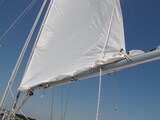Remote Acess came with a 150% genoa and mail sail with four small battens and one reef point. For the wind conditions on Outer Cape Cod the 150% genoa was useless most of the time. First the genoa was cut down. This didn't work well but was still an improvement. A season later a second set of reef points was put in the main and new headsails were ordered. This has worked very well though for the occasional light air more canvas would be nice to have.

The original reef point reduces sail area by about 25%. The second reef point was placed so as to reduce sail area by about 45%. This would allow comfortable sailing at the quite common 20-25 knots and might not feel overpowered until 30-35 knots. Beyond that the sail material is likely to be too light and sailing with this sail would risk tearing the sail. A third reef could be put in, reducing sail area by 60% or more, but might tear the sail. We did want a new mainsail, but shreading the old one in high wind might not be the best way to make the decision. Sailing in above 30-35 knots should probably be done with a replacement mainsail, with heavier sail material in the top triangle specifically for this reason.
The table below provides estimates of the sail area and sail area reduction for various reef points. The dimensions are approximately those of the Compac 23 mainsail and the reef points that are now in it.
| reef points: | 22 foot sail luff: (8.5 ft sail foot = 93.5 sq ft) | AREA | ||
| 19 ft (3 ft up) | 86.5% of length | 75% of area | 25% reduction | 69.7 sqft |
| 16 ft 9 in (5.75 ft up) | 73.9% of length | 55% of area | 45% reduction | 51.0 sqft |
| note: straight leach assumed for ease of computation. All sails have a curved leach that will add some area, most significant as a percentage with the smallest reef. | ||||
Ignoring the small area added by a curved leach, sail area for a triangular sail where there is a right angle at the sail foot is proportional to the square of the luff length. For example, raising the luff by 20% always results in a 4/5 luff length, and 16/25 or about 60% of the sail area. Raising the luff by 33% reduces the luff length to 2/3 and therefore the sail area to 4/9 or about 44%. This is true regardless of luff length or foot length. Even for a full batten mainsail with a large leach area, the error can be ignored for the purpose of estimating sail area reduction and still come within 5-10 at the very worst%.

The original headsail was poorly suited for conditions we sail in. It was a 150% genoa. The standing rigging did not allow the sail to be sheeted in tight if the sheets were passed outside of the upper shrouds. The sail pressed against the upper shroud when close hauled. That sail was cut down but put the ideal point of attachment further forward than the genoa track permitted.
North Sails made up two custom jibs. One is a working jib, approximately 110% of the foretriangle area. The other is a heavy air jib, about 60% of the sail area of the working jib. The sails were both a little too long grommet to grommet along the luff for the new ProFurl furler. This was corrected by shortenning the link plates on the ProFurl and adding a slightly longer section of foil. This is our first season with these sails and partly due to problems with the furler that were no fault of ProFurl we don't have much experience with these sails. What experience we have, even with not being able to fully tension the luff has been excellent. More on this later.
![]() Previous Page: Sail control and rigging
Previous Page: Sail control and rigging